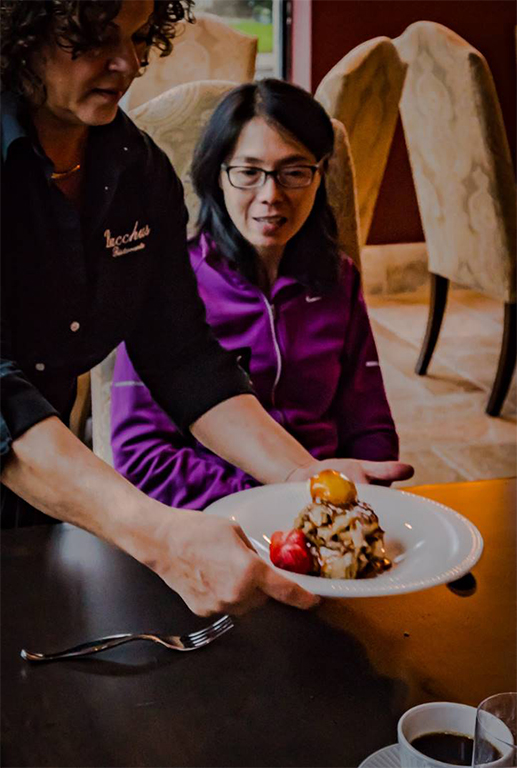The facade of fine dining

Toni Spadafora serves desert to Yen Tran at Bacchus Ristorante on Oct. 12, 2017. The fine dining establishment is hosting New Year’s dinner with an after-party at the Low-Martin House in Walkerville. (Photo by David Lafreniere)
By David Lafreniere
If the walls of the historic Low-Martin House in Walkerville could talk – the stories they would tell. The walls’ whispers through the generations, have escaped the confines of this gentrified estate to breathe new life beyond its many corners.
Bootlegger Harry Low built the home in 1928. Later it was home to prominent Canadian politician Paul Martin Sr. where it became the childhood home of his son and future Prime Minister Paul Martin Jr.
After the Martins, the home fell into a state of disrepair until it was purchased in 2012 by craftsman and owner of BetterMade Cabinets Vern Myslichuk.
What followed was a three-year restoration of the home to bring it back to its original form and beauty.
“Originally, he intended the home to be a private residence but realized the living history of the home should be open to the public for events and tours,” says Jenifer Ralston, manager of Bacchus Ristorante.
“If you book dinner at Bacchus for one of our two sittings on New Year’s Eve you can attend an after-party at the Low-Martin house to ring in the New Year.”
At the corner of Erie Street East and Lilian Avenue in Windsor’s Little Italy district, a Roman Gothic revival is almost complete. The building, which houses Bacchus, is another project of Myslichuk’s. He is renovating the building to new glory by using art in the construction of the new façade.
The building’s new façade is reminiscent of ancient Europe where faux marble pieces are individually sculpted to provide a unique artistic exterior.
“The idea is to reflect an authentic Italian architectural design not only in the façade but in the interior of Bacchus Ristorante. We want to deliver the elegance, style and a craftmanship experience to our guests through their entire dining experience,” says Ralston. “Guests will experience an ambience matched with a high level of customer service and fine dining provided by our executive chef Bledar Garunja.”
Formerly the manager of the Windsor Club, Ralston was happy when Myslichuk asked Garunja to join and help her create a fine dining experience that would be the best the city had to offer.
Garunja believes plating his creations is an important part of the fine dining experience.
“People first eat with their eyes so it’s important to make sure food is presented in a manner that will compliment the meal and overall dining experience,” says Garunja. “I often create height with a dish by stacking ingredients to enhance the visual appeal.”
It took some getting used to describing dishes as works of art for hostess and server Toni Spadafora who owned the restaurant before Myslichuk bought it from her.
Opened in 1988 Ristorante Calabrisella was Spadafora’s until this summer when Myslichuk made her an offer she couldn’t refuse. She accepted his offer because she agrees with Myslichuk’s vision for the building and what it will bring to Erie Street’s Little Italy.
“Vern is trying to create something new and exciting on Erie Street and I am happy to be a part of it,” says Spadafora. “I love people and interacting with them and since opening as Bacchus I’ve seen how treating food as art and describing it that way enhances the experience for our diners.”
In Windsor on a business trip Yen Tran, a Toronto pharmacologist, took in the dining experience at Bacchus.
The description of menu offerings by the server, the presentation on the plate by the chef and the luxurious feel of the place all feed into an ultimately fine cuisine, according to Tran.
“I felt like I could taste the rack of lamb as it was being described and when it arrived it was almost too beautiful to eat,” says Tran.
Later this month another storefront in the building currently being used as a workshop for the façade will begin its own transformation.
Ralston says that by the spring the fine dining experience will be complimented when the workspace is converted to an elegant cocktail lounge called Verna-Q-Lar.


